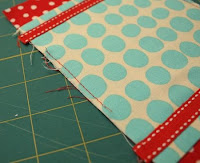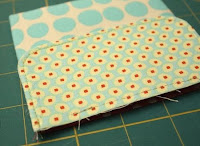Tiny little wallets that fit just perfectly into the mini clutches from my first official pattern, The Infinity Tote.
It's perfect for the minimalist (like me) who wants just enough wallet to cart around a few credit cards, a bit o'change, and some greenbacks. After lugging a huge diaper bag around for 8 years with everything but the kitchen sink, it's so nice to be able to grab a tiny tote when I'm running a couple of errands or spending a day playing tourist.
It's also a great way to make use of extra little scraps you may have lying around, begging to be made into something useful and pretty.
The front pocket is designed for coins, the middle area is for bills, and
the back pocket holds credit cards/drivers license.
I feel like I should issue a bit of a warning about this little wallet, though - despite its benign appearance, it's not exactly a project for beginners. Not because of a lot of complicated pieces, but because it's so tiny that it's pretty hard to do a really good job constructing it. Any slight variance in seam allowance or the tiniest error in alignment will result in a glaringly obvious crooked pocket or flap, so be patient and do your very best when stitching it together to avoid problems.
I went through 5 prototypes (2 were complete rejects because things were crooked and didn't fit well together) to get all the measurements exactly right, so be precise! Cut the pieces EXACTLY square and to the measurements given. And be sure to sew EXACTLY 1/4" seams so the parts will fit together well.
Okay, I hope I didn't scare anybody too badly...I just wanted to give you a heads up so you didn't run into the same problems I did during construction.
The first step is to cut all the pieces. You can look at the finished product in photos above to see which fabric goes where, but basically you'll need 2 separate fabrics for the cover flap and main body of the bag, plus a long piece that will be doubled over to create your pockets. In this example, the blue dots fabric is for the pockets.
Main body (cut 2): 5" x 7 3/4"
Cover flap (cut 2): 5" x 2 1/2"
Pockets (cut 1): 5" x 12"
INTERFACING (heavy duty, fusible on one side like Pellon DuraBond):
Main body (cut 1): 4 1/2" x 7 1/4"
flap (cut 1): a scant 4 1/2" (meaning just shy of 4.5") x 2 1/4"
HINT: To get a nice curve on the interfacing, use a spool of thread as a guide and trace around it on one corner.
Fold interfacing in half, then trim along that line to create 2 perfect, uniform curves.
Fuse the interfacing to the backside of your chosen fabric. These will be the pieces that will be facing outward, not the lining pieces (although I must confess that I wasn't concentrating and accidentally sewed the flap for this wallet wrong-side out...I had intended for the little red-dotted "Seed" fabric to be facing out and, as you can see in the finished product, I did it wrong. Just in case you noticed and were confused about that.)
With right sides together, sew the short ends of the pocket fabric together to create a "tube". Put the 2 fabrics for the flap right sides together, and stitch VERY carefully all along the edge of the interfacing to create the curve. Be sure to backstitch at beginning and end.
Trim the seam around the flap very close (but not too close!) to where you just stitched.
Turn the pocket "tube" right side out and press flat, with the seam right at the edge of one of the pocket sides. If desired, stitch ribbon along the edges of pocket as shown. Make sure ribbon is sewn on straight = a crooked ribbon will be very apparent later on.
NOTE: press the ribbon with a hot steam iron BEFORE stitching onto pocket fabric. Ribbon can shrink and could cause fabric to pucker if not pressed beforehand.
Turn flap right side out, press very carefully, and topstitch all along the sewn edge.
Reduce the stitch length to about a 2 so that you can navigate the corners more precisely, and go very slowly (sometimes I even "walk" the needle through the corner areas instead of using the foot mechanism) so you can do a good job.
Set aside.
Now, take the completed pocket fabric and center it on the Main Body fabric (the one with interfacing fused to it). Using a long stitch length (4 or 5), baste 1/16" away from edge for a few inches on either side of pocket fabric so that it won't shift when you sew up the sides. Take great care in making sure the pocket is sewn on straight. If it isn't, rip out the basting and do it again until it's straight so you won't end up with crooked pockets.
With right sides together, stitch up the sides of both the Liner and the Main Body fabric (the one you just basted the pockets to). Make sure that whatever version of 1/4" seam allowance (everyone sews 1/4" a little differently based on different machines) you use on one, you do the exact same to the other or they will not fit together properly. Clip the bottom corners slightly as shown above.
Leave the liner inside out as shown above.
Turn Main Body fabric right side out, press well.
Take your flap and baste it in place (1/16" seam) along the backside of the wallet.
Now, take the liner (which is still inside out) and slip it over the top of the wallet and flap so that the raw edges meet up exactly and the side seams match up.
Okay, this is the tricky part. Starting at where you basted the flap to the Main Body, stitch exactly 1/4" seam all the way around the wallet. If this seam varies at all, the wallet and flap will be crooked. Since it is so small, I recommend stitching it from the bottom inside as shown above, which is opposite of how I would normally stitch a bag.
Using a seam ripper, take out part of the side seam of the liner. Pull wallet out through this gap.
It will now look like this. Stitch up the gap either by slipstitching by hand or stitching close to the edge with machine like the photo above.
Tuck lining into wallet and press well.
To make the coin pocket gravity proof, take *Fusible* Velcro (especially designed for fabric, not the gummy stick-to-everything kind) and cut to about 4" long. If it's 3/4" wide, cut in half lengthwise to make a skinny strip. Following manufacturers directions, slip both sides of Velcro into pocket near the top and fuse in place. Let cool then make sure it fused properly.
If using a decorative button for the outside flap, sew in place now.
On the backside of the flap, sew on a little snap closure right over where the button thread is (to hide it) and then sew on the other half of the snap onto the pocket.
And there you have it! A customized, compact little wallet to brighten your spirits (and lighten the load in your purse) every time you pull it out.






















No comments:
Post a Comment